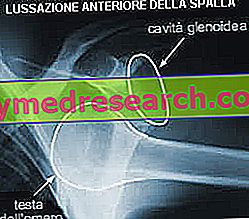Shoulder joint and dislocations
The shoulder is an area of the human body that is extremely complicated because it is formed by the combination of 5 joints. Among these, the main one is called scapulomeral or glenomeral because it connects the head of the humerus with the glenoid cavity of the scapula.

In particular situations, such as a strong bruise, this protection fails to prevent the head of the humerus from coming out of its normal seat, without returning spontaneously. One speaks in these cases of dislocation of the shoulder or glenomeral dislocation.
This important articulation can be affected by two different types of dislocations. The most frequent (95% of cases), especially in young and active people, is the anterior luxorection in which the humerus is deviated forward and down, as shown in the figure.
The posterior dislocation is instead much less frequent and a little more complicated to treat.
DISLOCATION
Dislocation or dislocation is a traumatic event that causes the loss of mutual relations between the articular heads of a joint. Cartilaginous slippage of the two bone ends is allowed by the breakage, at least partially, of the capsule and ligaments that stabilize the joint. Sometimes these lesions are associated with those of articular cartilage, vessels, bones, skin (exposed dislocation) and nerves.
The dislocations are divided into complete and incomplete. In the first case there is a clear separation between the two articular surfaces, while in the second case the bony heads remain partially in contact with each other. In both cases, external intervention is required to bring the two articulated surfaces that have come out back into place.
Dislocation of the shoulder can cause the rupture of numerous anatomical structures (ligaments, bones, skin, articular cartilage, muscles and capsule). In particular about 90% of the anterior dislocations are accompanied by the detachment of the glenoid lip, a sort of seal that allows the humerus to slide on the homonymous scapula cavity.
After the lesion this cartilaginous lip tends to reposition itself spontaneously and to heal but sometimes it assumes a flawed position that decreases its functionality. This condition, called Bankart lesion, is one of the most common causes of recurrent dislocations and for this reason, especially in younger subjects, it is often treated surgically.
The dislocation can also be accompanied by the rupture of the head of the humerus which is violently pushed against the anterior border of the glenoid cavity (lesion of Hill Sachs). This fracture also increases the risk of recurrent dislocations but is more frequent in the elderly than in the young.
Causes and risk factors
Shoulder dislocation is a fairly common injury in contact sports such as hockey, basketball, rugby, baseball, skiing and wrestling. This condition occurs more frequently in men than in women (9: 1) and in young people than in the elderly.
The damaging mechanisms are different but all referable to a strong traumatic event that causes the humerus to be disclosed from its natural site:
- fall in support on an over-rotated arm (when you fall, you tend to rotate your arm outward to create a solid support point to protect the rest of your body)
- severe trauma on an arm that is under-rotated and adducted (posterior dislocation)
- fall on the lateral side of the shoulder
- abrupt movement of the arm above the head (throwing of the baseball)
- violent jerk of the arm backwards and outwards from an opponent
- violent collision of the shoulder against an obstacle or an opponent
- congenital hyperactivity (natural predisposition to instability) or acquired (following previous dislocation)
- chronic incurability of the shoulder due to overtraining (chronic overload of the stabilizing muscles)
Symptoms
- Impossibility of movement
- The arm remains dangling, extra-rotated and close to the body (anterior lesion)
- Violent and annoying pain
- The shoulder, on palpation, loses its characteristic roundness
Diagnosis
The diagnosis of dislocation is often rather immediate, given that joint damage is visible to the naked eye or otherwise palpable. However, in order to have a complete clinical picture it is good to undergo, before repositioning, diagnostic investigations such as radiographs and magnetic resonance imaging. These tests can highlight any complications (bone fractures, lesions of vessels, nerves, etc.). The radiographic examination will then be repeated after the repositioning procedure to verify the articular alignment. If you want to correctly highlight a posterior lesion, you must instead use special radiographic techniques.
Treatment and rehabilitation
Like all sprains, shoulder dislocation also requires timely reduction (repositioning). This maneuver must be performed exclusively by a doctor, usually after an X-ray examination. Often this intervention is performed under local anesthesia to limit pain.

Especially in recurrent lesions it is advisable to start early mobilization exercises associated with a subsequent muscle strengthening program. On the other hand, young athletes tend to prolong immobility to promote complete healing of injured anatomical structures. Even in these cases it is still important to perform regular exercises for early mobilization of the wrist, hand and elbow.
Statistically, the likelihood of recurrent shoulder dislocations is greater in patients under the age of 30 (approximately 80% of cases). Above this age the chances of a future dislocation decrease significantly.
Also for this reason the rehabilitative treatment differs based on the age of the subject, the severity of the dislocation and the recurrence of the pathology. It is indeed of FUNDAMENTAL importance to avoid new luxative episodes, given that with each new dislocation the risk of damaging important anatomical structures increases considerably. For this reason the surgery becomes almost a must in case of frequent dislocations.
A dislocated dislocation can cause, with the passage of time, degenerative phenomena of the articular cartilage or however seriously compromise the functionality of the shoulder (pain, lack of strength, alterations of sensitivity).
For this reason and to counter the danger of new luxative episodes in young athletes, we often proceed with an arthroscopic repositioning of the glenoid labrum and articular ligaments. The results of the intervention are usually very good given that around 95% of patients resume normal sports and daily activities without suffering new dislocations. The effectiveness of this intervention is similar to that of the traditional open-air technique which further reduces the risk of recurrence but is rather invasive. Healing times after surgery are on average between 45 and 180 days, while light conservative activities can be undertaken for 2-4 weeks after the injury.
To learn more: The dislocations
Frozen shoulder



